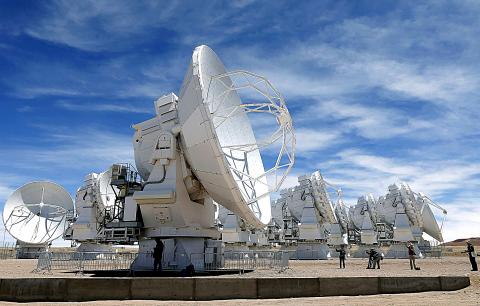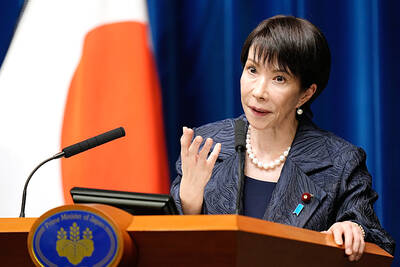The National Science Council (NSC) and Academia Sinica yesterday announced that an international astronomy project, the Atacama Large Millimeter Array (ALMA), an array of radio telescopes located in Chile, in which Taiwan has participated, was launched on Thursday.
The ALMA project is an international project including countries from Europe, North America and East Asia, in cooperation with Chile. The project has installed 66 high-precision antennas with 12m and 7m diameter radio telescopes, which are capable of observing at wavelengths of between 0.3mm and 9.6mm, on the Chajnantor Plateau 5,000m above sea level in northern Chile.
Wang Jye-ming (王杰明), research fellow and deputy director of Academia Sinica’s Institute of Astronomy and Astrophysics, said the high resolution and sensitivity of the array is expected to provide insights on planet formation, star births during the early universe or even the origin of life and the solar system.

Photo: EPA
“As an example, the power of the ALMA’s high resolution is like being able to use a telescope at Kenting (墾丁) in Pingtung County to observe a coin or a ladybug on the tip of Taipei 101,” Wang said, adding that the ALMA’s resolution is about 10 times that of the Hubble Space Telescope.
The Taiwanese research team’s contribution to the ALMA project is mainly on the East Asia Front-End Integration Center — integrating the front-end components into front-end assemblies and testing all the integrated front-end assemblies before they are delivered to Chile, as well as having built two Front-End Service Vehicles.
The ALMA project began calls for academic research project proposals in late 2011, and Taiwan’s research teams acquired 10 projects in the first year and 14 projects last year, Wang said.
NSC Minister Cyrus Chu (朱敬一) said that because Taiwan would cover about 5 percent of the project’s total cost until 2016, the approval rate of Taiwanese research teams’ proposals for academic research with the ALMA had been about 7 or 8 percent since 2011, showing international recognition of Taiwan’s research and execution abilities.

The Ministry of Foreign Affairs (MOFA) yesterday voiced dissatisfaction with the Comprehensive and Progressive Agreement for Trans- Pacific Partnership (CPTPP), whose latest meeting, concluded earlier the same day, appeared not to address the country’s application. In a statement, MOFA said the CPTPP commission had "once again failed to fairly process Taiwan’s application," attributing the inaction to the bloc’s "succumbing to political pressure," without elaborating. Taiwan submitted its CPTPP application under the name "Separate Customs Territory of Taiwan, Penghu, Kinmen and Matsu" on Sept. 22, 2021 -- less than a week after China

THE GOOD WORD: More than 100 colleges on both sides of the Pacific will work together to bring students to Taiwan so they can learn Mandarin where it is spoken A total of 102 universities from Taiwan and the US are collaborating in a push to promote Taiwan as the first-choice place to learn Mandarin, with seven Mandarin learning centers stood up in the US to train and support teachers, the Foundation for International Cooperation in Higher Education of Taiwan (FICHET) said. At the annual convention of the American Council on the Teaching of Foreign Languages held over the weekend in New Orleans, Louisiana, a Taiwan Pavilion was jointly run by 17 representative teams from the FICHET, the Overseas Community Affairs Council, the Steering Committee for the Test of Proficiency-Huayu, the

A home-style restaurant opened by a Taiwanese woman in Quezon City in Metro Manila has been featured in the first-ever Michelin Guide honoring exceptional restaurants in the Philippines. The restaurant, Fong Wei Wu (豐味屋), was one of 74 eateries to receive a “Michelin Selected” honor in the guide, while one restaurant received two Michelin stars, eight received one star and 25 were awarded a “Bib Gourmand.” The guide, which was limited to restaurants in Metro Manila and Cebu, was published on Oct. 30. In an interview, Feng Wei Wu’s owner and chef, Linda, said that as a restaurateur in her 60s, receiving an

MORE RETALIATION: China would adopt a long-term pressure strategy to prevent other countries or future prime ministers following in Sanae Takaichi’s steps, an academic said Taiwan should maintain communications with Japan, as Japanese Prime Minister Sanae Takaichi is to lead a revision of security documents, Taiwanese academics said yesterday. Tensions have risen between Japan and China over remarks by Takaichi earlier this month that the use of force against Taiwan would constitute a “survival-threatening situation” for Japan. Prospect Foundation president Lai I-chung (賴怡忠) yesterday said Takaichi’s stance regarding Taiwan is the same as past Japanese prime ministers, but her position is clearer than that of her predecessors Fumio Kishida and Shigeru Ishiba. Although Japan views a “Taiwan contingency” as a “survival-threatening situation,” which would allow its military to